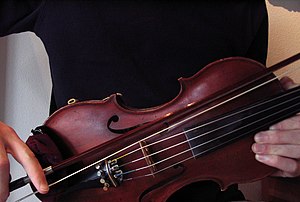“Subharmonics” innovator Mari Kimura connects herself with a computer using a wireless, fingerless glove that meticulously tracks bow strokes to get to the root of expression
Halfway into a recent performance at New York City’s Bohemian National Hall violinist Mari Kimura had already performed “Preludio” from Bach’s Partita No. 3 in E Major followed by several pieces in which she deftly demonstrated her innovative “subharmonics” techniques for extending the octave range of her instrument. Then things got really interesting.
Kimura donned a white fingerless glove laden with wireless sensors, plugged her “augmented” violin into her laptop onstage, and proceeded to demonstrate how she is redefining the relationship musicians have with both their instruments and their music. After a few moments setting up her interactive bowing technology Kimura launched into her composition Voyage Apollonian, during which her bow strokes controlled an animation sequence created by New York University computer science professor Ken Perlin. As she played, the glove’s sensors sent data to software running on her laptop, prompting a black-and-white butterfly on the large screen behind her to morph into various shapes and patterns before returning to its original winged configuration.
The sensors are part of module that includes 3-D accelerometers and three axis gyroscopes as well as a wireless transmitter that sends data about Kimura’s bowing to her computer as she plays. The module functions as an electronic controller for real-time digital sound processes, such as sound transformation and sound synthesis, says Frédéric Bevilacqua, who leads the Paris Institut de Recherche et Coordination Acoustique/Musique’s (IRCAM) Real-Time Musical Interactions Team, which developed the module.
Augmented violin
IRCAM’s augmented violin technology—its first prototype was built in 2004—tracks all bow attacks and bow angles, Bevilacqua says, adding, “We specifically worked on a gesture recognition and synchronization system that is able to distinguish standard bowing styles, such as détaché or martelé, or to recognize a bow pattern specifically chosen by the musician.” Others who have used IRCAM’s technology include composer Florence Baschet and dancer/choreographer Richard Siegal.
The augmented violin project appeals to Kimura’s experimental side, but she is hesitant to draw specific conclusions based on the data produced by the sensors. “When I first learned about the technology I was really excited because bowing is what makes the violin really live,” says Kimura, who teaches a graduate class in computer music interactive performance at The Juilliard School in New York City. “I wanted to study: Where does expression lie in? How does bowing motion contribute to the expression? For engineers it would be so easy if the bowing motion itself equaled expression, but it doesn’t.”
IRCAM’s original idea was to attach sensors to the violinist’s bow and a battery for the sensors to Kimura’s wrist, but she found this cumbersome and moved the sensors and battery to a makeshift glove worn on her right hand. Her first performance using the glove came in 2007. Two years later she was approached by designer Mark Salinas, who revamped the look and designed the version of the glove that Kimura wore during the second half of her recent New York performance.
Kimura’s work has taken IRCAM’s technology in new directions. Instead of using the system of violin, sensors and software to analyze and reproduce certain sounds, Kimura is more interested in studying her relationship with her instrument. “How you get to the string and how you end your stroke—that’s where the character of the bowing is,” she adds.
Related articles
- Motion tracking glove brings musical innovation (charlotte.news14.com)










